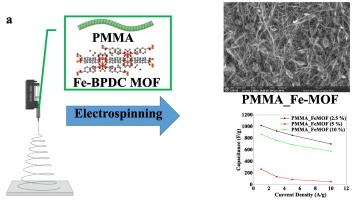超级电容器用铁金属有机框架(MOFs)基静电纺丝纤维
IF 5.1
3区 工程技术
Q1 CHEMISTRY, APPLIED
引用次数: 0
摘要
采用静电纺丝法合成了铁基金属有机骨架(fe - mof),并将其掺入聚甲基丙烯酸甲酯(PMMA)中制备了PMMA_Fe-MOF纳米纤维。采用x射线衍射(XRD)、衰减全反射傅里叶变换红外光谱(ATR-FTIR)和扫描电子显微镜(SEM)对材料进行分析。电纺丝材料直接集成到泡沫镍(NF)电极中,用于储能应用,例如超级电容器。采用循环伏安法(CV)、恒流充放电曲线法(GCDC)、线性扫描伏安法(LSV)和电化学电位动力学再激活法(EPR)对其电化学性能进行了评价。PMMA_Fe-MOF电极表现出优异的电容性能,在负载2.5% Fe-MOF时,在1 A/g时的比电容可达1017.5 F/g。我们的研究结果强调了电纺fe - mof基复合材料作为超级电容器高性能电极材料的前景,具有直接,无粘结剂的制造过程。该材料的结构稳定性和电化学特性表明其在储能领域具有潜在的应用前景。本文章由计算机程序翻译,如有差异,请以英文原文为准。

Ferric metal-organic frameworks (MOFs)-based electrospinning fibers for supercapacitors
Ferric-based metal-organic frameworks (Fe-MOFs) were synthesized and incorporated into poly(methyl methacrylate) (PMMA) using electrospinning to produce PMMA_Fe-MOF nanofibers. The materials were analyzed using X-ray diffraction (XRD), attenuated total reflectance Fourier-transform infrared spectroscopy (ATR-FTIR), and scanning electron microscopy (SEM). The electrospun materials were directly integrated into nickel foam (NF) electrodes for energy storage applications, e.g., supercapacitors. The electrochemical performance was assessed using cyclic voltammetry (CV), galvanostatic charge-discharge curves (GCDC), linear sweep voltammetry (LSV), and electrochemical potentiokinetic reactivation (EPR). The PMMA_Fe-MOF electrodes exhibited outstanding capacitive performance, achieving specific capacitances of up to 1017.5 F/g at 1 A/g for the 2.5 % Fe-MOF loading. Our findings highlights the promise of electrospun Fe-MOF-based composites as high-performance electrode materials for supercapacitors, featuring a straightforward, binder-free manufacturing procedure. The materials' structural stability and electrochemical characteristics indicate potential use in energy storage applications.
求助全文
通过发布文献求助,成功后即可免费获取论文全文。
去求助
来源期刊

Reactive & Functional Polymers
工程技术-高分子科学
CiteScore
8.90
自引率
5.90%
发文量
259
审稿时长
27 days
期刊介绍:
Reactive & Functional Polymers provides a forum to disseminate original ideas, concepts and developments in the science and technology of polymers with functional groups, which impart specific chemical reactivity or physical, chemical, structural, biological, and pharmacological functionality. The scope covers organic polymers, acting for instance as reagents, catalysts, templates, ion-exchangers, selective sorbents, chelating or antimicrobial agents, drug carriers, sensors, membranes, and hydrogels. This also includes reactive cross-linkable prepolymers and high-performance thermosetting polymers, natural or degradable polymers, conducting polymers, and porous polymers.
Original research articles must contain thorough molecular and material characterization data on synthesis of the above polymers in combination with their applications. Applications include but are not limited to catalysis, water or effluent treatment, separations and recovery, electronics and information storage, energy conversion, encapsulation, or adhesion.
 求助内容:
求助内容: 应助结果提醒方式:
应助结果提醒方式:


